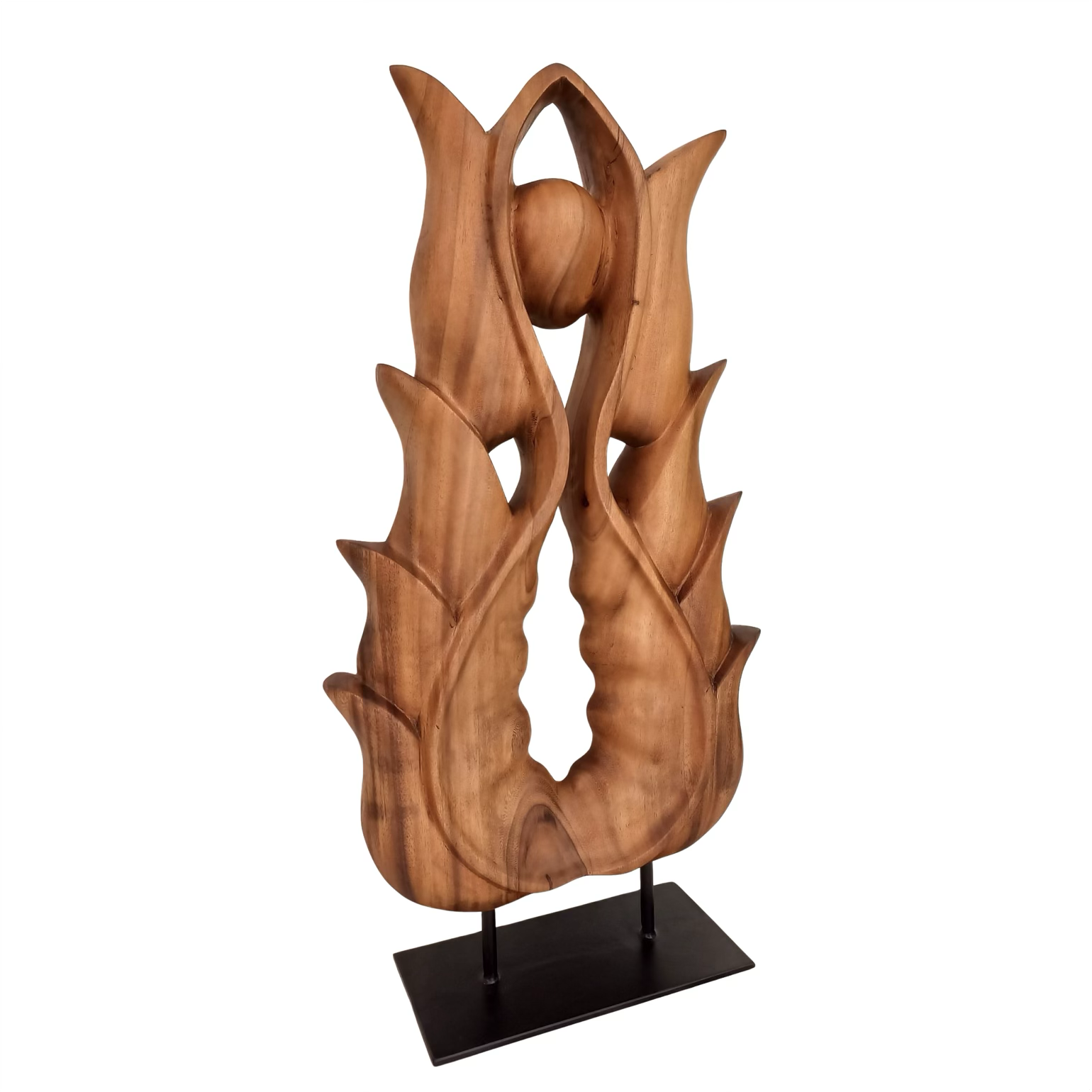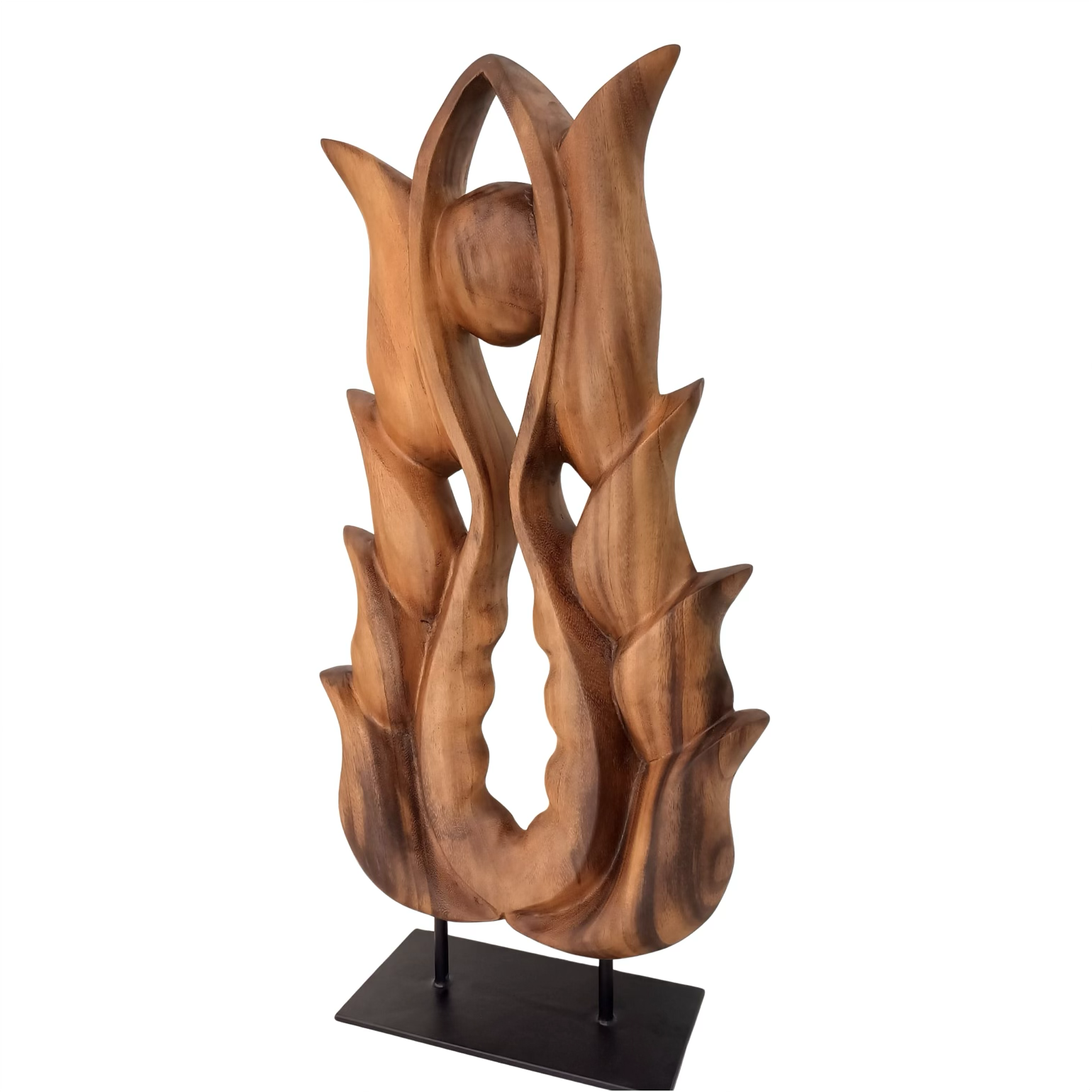Artist’s note
Sometimes, not too often luckily, people ask me where I get my inspiration from when designing sculptures. My standard, and slightly premeditated, response usually references my personal and professional interest in mathematics and biology. That makes perfect sense though: I teach those two subjects on a daily basis and there is plenty of interesting visual imagery in both fields. And indeed, many of my sculptures have clear references to mathematical and/or biological themes, as does this one. A satisfying answer therefore but it is only part of a story that is, perhaps disappointingly, much more mundane. I typically start with, simply, sketching smooth curvatures - as I had to do endlessly by hand when studying math as a somewhat younger man (although nowadays I use technology to plot 3D curves and surfaces. Not that I want to imply that I use cleverly chosen mathematical equations for guidance. Far from it, that would make the whole design process sound much more intellectual than it actually is). Basically, I just start doodling, like we all do when we’re bored. But doodling intentionally, even if intuitively, with an eye on the particular dimensions of the piece of wood, hoping that something good will manifest itself eventually.
Usually it doesn’t, not at firsrt anyway. I dismiss, discard, start again, in many iterations. Constantly trying to imagine what this 2D sketch, on paper, might look like in 3D, in wood: is this too simple, or too complex? Too pretentious, too much symbolism, too abstract or not abstract enough? Wrecking my brain, imagining it from all angles. Evenings pass, sketching stuff that ends up in the bin. I am getting worried that my biggest legacy will be a trail of wasted paper, pencils and erasers. There is, only, an infinite number of sculptures I can make from this piece; even when considering my own technical limitations, because there is definitely a much bigger infinite number of sculptures I cannot make. That thought in itself is potentially overwhelming and I need to ignore it otherwise I’ll never decide on doing anything. This reminds me of Willem Kloos, one of our revered Dutch writers, who wrote in 1894: ‘I am a God in the depths of my thoughts’. I have so many fleeting ideas, in the depths of my thoughts, some brilliant (but admittedly most not), about the next best sculpture, but how do I take that thought and convert it into something real? Can I even get close to what my imagination projects on my inner retina? Most likely never. It also reminds me of one piece of advice I give my students when trying to tackle challenging math problems: ‘Do Something’. Just start from what you know works, even if you have no idea yet where it will end. Have faith: something good will happen, once you start. Bottom line here is that my inspiration comes from within, of course fed by external imagery and ideas, twisted by my own gut feeling of what is needed to be successful in the end, and, not unimportantly, in combination with perseverance. Nothing complicated is going to be easy, after all.
In the process of sketching potentials (as I would refer to them), I do need to reach a certain level of satisfaction before deciding on a design, knowing that I will painstakingly work on the wood for a few months after committing myself, going through some serious ups and downs in the process, fluctuating on a daily basis between highs of certainty (“yes, this will look like a master piece, keep on going”) and depths of uncertainty and self-doubt (“this is painfully mediocre; burn the damn thing and, honestly: why bother? Just stop and get a life. Go cycling.”). This aspect is related to the nature of wood sculpting: there is little room for redesign once you start chipping away, in contrast to many other areas of artistic expression.
In this piece the biological component clearly stands out. When I incorporate ‘biological themes’, my designs lean towards feminine curvatures and, in this occasion, obviously, female genitalia. The piece hints at the female parts of a flower, a pistil with an ovary, ovules, style and stigma with a pollen grain in the top (or is it a seed already?), as well as a vagina which, I’ll admit, was my initial intention when I started sketching. Talk about inspiration! What is it that makes the vagina so intriguing, apart from simply being beautiful? Bookshelves must have been written about this so I won’t even attempt to discuss it in all aspects here: even if I have seen quite a few of them, that does not make me an expert necessarily, but these are my two cents. We spent nine months in such a comforting, warm environment, the uterus, supplied with nutrients and oxygen, distant sounds and alterations of darkness and light, blissfully unaware of the transition into a much colder, harsher environment in which we have to learn how to fend for ourselves. No wonder there is a desire to return to that state of being. To return to that birth channel, the passage way between before and after. The interface between generations. The passageway into the unknown. The seat of inspiration.
PS The title ‘Seat of Inspiration’ is also an insider’s reference to a song I once composed when playing in a band during my college years and wrote my own lyrics: ‘Look for the seeds of inspiration and spread them through your mind. Feed them with your memory and thoughts of any kind’. This song still lingers somewhere on Youtube I just noticed. Maybe I should just send the link to this recording, whenever someone asks about my source of inspiration.




